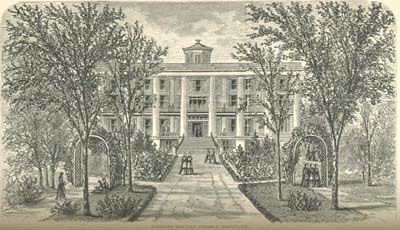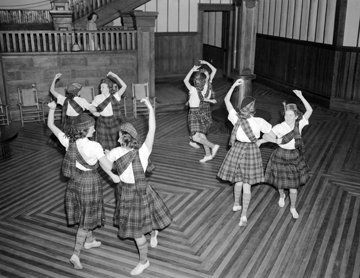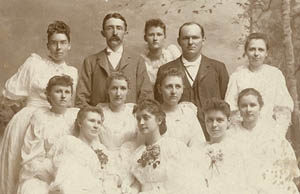North Carolina Women's Colleges
By Jennifer Davison and Jaime Huaman, Government & Heritage Library, 2010; Kelly Agan, Government & Heritage Library, 2014, 2016, 2017. Revised October, 2022.
Four years before the Declaration of Independence was signed, North Carolina’s first woman’s college was founded. Salem College in Winston-Salem is the oldest female educational establishment in the country that is still a women's college. Since 1772, twenty-eight women’s schools have been established in North Carolina. Many no longer exist, or have become coeducational. Currently there are four women’s colleges in North Carolina: Bennett College, Meredith College, Peace College, and Salem College.
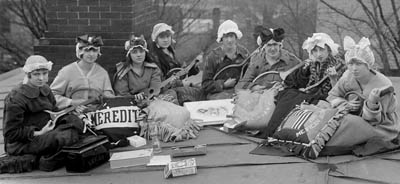 It should be noted that the term “college” has in the past been used to describe schools that today would be known as high schools. Since these schools were an attempt to create institutions of higher learning for female North Carolinians, they have been included in this list regardless of the level of their curriculum. When possible, we have noted if the school granted advanced degrees as we know them today.
It should be noted that the term “college” has in the past been used to describe schools that today would be known as high schools. Since these schools were an attempt to create institutions of higher learning for female North Carolinians, they have been included in this list regardless of the level of their curriculum. When possible, we have noted if the school granted advanced degrees as we know them today.
Asheville Female College – Asheville, NC
Asheville Female College was founded in 1842 as Asheville Female Seminary by Presbyterians in Asheville. In 1851, in order to avoid closure, the college affiliated itself with the Methodist church and was renamed Western Carolina Female College. The college was forced to close during the Civil War by Union forces, and in 1869 the school was sold to pay off church debts. At this time the school assumed the name of Asheville Female College. In 1873-74 the school offered post-graduate work and degrees in “Mistress of Arts and Sciences” were granted to graduates. Elizabeth Blackwell, who was a member of the faculty from 1845-1846, became the first woman in America to practice medicine.
Barber-Scotia College
Located in Concord, Barber-Scotia College was originally founded as a Presbyterian preparatory school for African American women by the Rev. Luke Dormand. It was originally named Scotia Seminary and had a focus to prepare young women to become teachers. In 1916, the name was changed to Scotia Women's College, reflecting its development into a junior college. In 1930, it merged with Barber Memorial College in Anniston, Alabama and then changed its name to Barber-Scotia College in 1932. In 1942, Barber-Scotia adopted a 4 year college curriculum. Although Barber-Scotia was historically a college for African American women, in 1954, the school's charter was changed to admit women and men regardless of race. For more information: Barber-Scotia College article in NCpedia (from the Encyclopedia of North Carolina).
Bennett College for Women - Greensboro, NC (Now Bennett College)
Bennett College is one of North Carolina’s Historically Black Colleges and Universities (HBCUs) and is one of the four remaining women’s colleges in North Carolina. It is also only one of two black women's colleges in the United States today (Spelman College, in Atlanta, GA, is the other). Bennett College began in 1873 as a school to train teachers and provide education to newly emancipated enslaved people. In 1926, Bennett College became a college for women. Over 5,000 women have graduated from Bennett College since 1930. Two alumnae of note: Dorothy L. Brown (first African American female surgeon in the south); Belinda Foster (first African American female District Attorney in NC).
Carolina College for Women – Maxton, NC
Chartered in 1907 by the North Carolina Methodist Conference, Carolina College for Women (CCW) opened its doors in 1912. It closed in 1926 for financial reasons, was sold to Presbyterian Junior College and then to the Carolina Military Academy. Although similar in name, it did not have any affiliation with the North Carolina College for Women. Information about the CCW can be found in the Methodist University archives.
Carolina Female College – Ansonville, NC
Founded in 1849 by a joint stock company in Ansonville, North Carolina, this institution was only open for 19 years. Two typhoid fever epidemics and political disputes among stockholders led to financial difficulties, and prior to the Civil War the school was turned over to the Methodist Church in order to pay debts. In 1868, the school closed and was used until 1885 as a high school. From 1885-1945, the building was used as apartments, and was demolished in the 1950’s.
Claremont Female College – Hickory, NC
The institution began in 1880 as the Claremont Female College. Four-year degrees and a specialization in music and education were offered. The school closed in 1915.
Charlotte Female Institute – Charlotte, NC
Charlotte Female Institute was founded in 1857 and from 1891–1896 it was called the Seminary for Girls. In 1896, the school became known as the Presbyterian College for Women. In 1912, anticipating the move to the present campus in the Myers Park neighborhood, the school became Queens College. After World War II the college became coeducational and in 2002 the name was changed to Queens University of Charlotte.
Chowan Baptist Female Institute – Murfreesboro, NC
The college opened in 1848 as the Chowan Female Institute and was renamed as the Chowan Female Collegiate Institute in 1850. Chowan was chosen as the school’s name as a way to honor the Native American Algonquin Chowanook (or Chawanook) tribe. In 1910, the school was renamed once again as Chowan College. The school began admitting male students in 1931 and was closed from 1943 until 1949. Chowan College is currently known as Chowan University.
Concord Presbyterian Female College – Statesville, NC
(entry co-written by Bill Moose, professor and historian at Mitchell Community College)
Started by Concord Presbytery in 1852, the college officially opened in the fall of 1856 as Concord Presbyterian Female College. Although Concord did have a primary and intermediate department that taught younger girls, the school had a four-year college program from its inception. In the economic hard times that followed the Civil War, the Presbytery was unable to support the college and sold it in 1872 to local businessman R. F. Simonton, who changed the name to Simonton Female College. In 1875, Eliza Mitchell Grant and Margaret Eliot Mitchell, the daughters of Elisha Mitchell, for whom Mount Mitchell is named, were hired to conduct the college. Under their leadership, the school made considerable progress and became a highly respected institution. It was at the urging of alumnae taught by the Mitchell sisters that the board of trustees renamed the college in 1917. In 1924, Mitchell shifted from a four-year to a two-year institution under the pressure of accreditation demands and the rising costs of maintaining them. In 1932, local men who could no longer afford to go away to college due to the Great Depression were admitted. In 1904, Concord Presbytery had regained control of the college, but once again relinquished it, in 1959, to the Mitchell College Foundation (a local non-profit group), which ran the college as an independent junior college until it was admitted to the North Carolina Community College System.
Davenport Female College – Lenoir, NC
Established in 1855 by the Methodist church as an all-girl school, the first classes at the Davenport Female College were held in 1857. The school remained open during the Civil War and was damaged when Union General George Stoneman raided Lenoir on April 15-16, 1865. In 1877, misfortune once again visited the school when sparks from a chimney caused the school to burn to the ground. Men were admitted to classes around 1893 and the school changed its name to Davenport College in 1915. The school had economic difficulties during the Great Depression and closed its doors in 1933. Five years later, all remaining assets of Davenport College merged with Greensboro College. The college’s buildings became Davenport Elementary School and the Caldwell Heritage Museum.
Edgeworth Female Seminary - Greensboro, NC
Chartered in 1840, Edgeworth Female Seminary was begun by Governor John Motley Morehead. The Seminary closed during the Civil War, then reopened for a short period (1862-1868).
Elizabeth College – Charlotte, NC
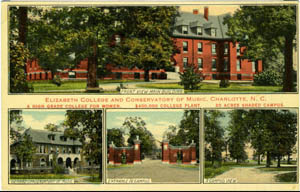 This school was founded in 1897 by Lutherans with cash and land donations from the citizens of Charlotte. In 1915, the school merged with Roanoke College for Women and lasted until 1921 when it burned. The buildings that Elizabeth College occupied in Charlotte are now occupied by the Presbyterian hospital.
This school was founded in 1897 by Lutherans with cash and land donations from the citizens of Charlotte. In 1915, the school merged with Roanoke College for Women and lasted until 1921 when it burned. The buildings that Elizabeth College occupied in Charlotte are now occupied by the Presbyterian hospital.
Flora MacDonald College – Red Springs, NC
This college started out as a Red Springs Seminary in 1896 with four acres of land and $4,000. It was soon renamed Southern Presbyterian College and Conservatory of Music in 1903. It was renamed again in 1914, to Flora Macdonald College in honor of Flora MacDonald, a Scottish woman who lived in North Carolina and in her youth helped Prince Charles Edward Stuart flee to safety during the Jacobite Risings. In 1958, the college merged with Presbyterian Junior College to become St. Andrews Presbyterian College, a co-educational institution.
Floral College – Maxton, NC
This college was established in 1841 by Presbyterians and had about 100 students attending the school every year until it closed, due to financial issues, in 1878.
Gaston College – Dallas, NC
Gaston College was created in 1887 as a four-year college for women to attend after finishing Gaston High School. The school existed until 1907 when the college building was sold to Gaston County.
Goldsboro Female College –Goldsboro, NC
This school opened in 1854 and conducted classes in the Borden Hotel until its permanent school location had finished construction in 1857. During the Civil War, the school was used as a hospital for both the Union and Confederacy. A four-year program was offered until it closed in 1871.
Greensboro Female College – Greensboro, NC
In 1838, members of the Methodist North Carolina Conference secured a charter for the Greensboro Female College from the State Legislature. The College opened its doors in 1846. The college closed for ten years, 1863-1873, when the school was destroyed by fire. In 1912 it was renamed to Greensboro College for Women. The College became Greensboro College in 1920 and in 1954 it became coeducational.
High Point Female College – High Point, NC
This institution of higher learning was chartered on March 15, 1889 and was created from the remnants of the Thomasville Female College. The college closed shortly afterwards, in 1893.
Judson College – Hendersonville, NC
Named after Adoniram Judson, a famous Baptist missionary, the construction of this school began in 1858, but the school did not open its doors until 1882. It eventually closed in 1892 due to financial reasons. During its existence the school was also known as Hendersonville Female College, Western North Carolina Female College, and Judson Female College.
Littleton College – Littleton, NC
This school was opened in January 1882 as Littleton Female College. By 1907 the school admitted 274 students a year. In 1912, the school was known as Littleton College. The school was never reopened after a devastating fire that destroyed several buildings on January 22, 1919.
Mecklenburg Female College – Charlotte, NC
This college opened in 1867 with the renting of the land and buildings of the North Carolina Military Institute in Charlotte. It was only in existence for two years.
Meredith College – Raleigh, NC
Although the North Carolina Baptist State Convention first spoke of a female seminary in 1835, the state only issued a charter for the school in 1891. The doors of Baptist Female University finally opened in 1899. The name was changed briefly to Baptist University for Women (1904-1909) before being renamed to Meredith College in honor of Thomas Meredith in 1909. Meredith College is one of the four remaining women’s colleges in North Carolina. Betsy Lane Cochrane, a 1958 alumna, became the first woman to serve in a leadership role in the NC General Assembly (House minority leader, Senate minority whip, Senate majority leader). Another alumna, Addie Davis, was the first woman ordained in a Southern Baptist Church. You can browse through Meredith College yearbooks online.
Oxford Female College – Oxford, NC
The College was established in 1851 by North Carolina Baptists. In 1904, the school was destroyed by fire but was soon rebuilt. It was renamed the Oxford Female Seminary and closed in 1925.
Salem College – Winston-Salem, NC
According to the American Council on Education in Washington, D.C., Salem College is the 13th oldest college in the United States and the oldest women's college by founding date (1772). Salem College was started by the Moravians. It began as a day school and in 1802 it became the first higher education institution for women in the state. Today, it is one of the four remaining women’s colleges in North Carolina. Salem College was known as both Salem Female Academy and Salem Academy and College. Elizabeth Pfohl Campbell (graduated 1923) was the first woman to found a PBS station. A description of life at Salem College can be heard in an oral history interview with Mary Turner Lane, an alumna.
St. Mary’s College – Raleigh, NC (Now St. Mary's School)
St. Mary’s opened its doors in 1842 with the help of the Episcopal Church. The school remained opened during the Civil War and was attended by Mildred, youngest daughter of General Robert E. Lee. Jefferson Davis’ wife and children stayed on the campus during 1862. During the 20th century, the school was a junior college. St. Mary’s College changed its name to Saint Mary's School in 1998 when it ceased issuing college degrees. Today St. Mary's is private girl's school for grades 9-12.
State Normal and Industrial School for White Girls – Greensboro, NC
In 1891, the North Carolina General Assembly created the State Normal and Industrial School for White Girls, the first public institution in the state to offer higher education to women. The school went through several names changes, becoming the North Carolina College for Women in 1919, the Woman’s College of the University of North Carolina in 1931, and finally the University of North Carolina at Greensboro in 1963 when it became coeducational.
Thomasville Female College –Thomasville, NC
This school was founded in 1849 as the preparatory school Sylva Grove Female Seminary and was later known as the Glenanna Female Seminary. In 1849, it gained college status and changed the name to Thomasville Female College. The school remained open during the Civil War. In 1889, the school merged with High Point Female College in High Point, NC.
Warrenton Female College – Warrenton, NC
Founded in 1841 as the Warrenton Female Collegiate Institute, the school was supported by first the Presbyterians and then the Methodists. The school increased its student population after Greensboro Female College burned, but when Greensboro reopened in 1873, the Warrenton Female College closed its doors for good.
Wesleyan Female College – Murfreesboro, NC
Founded by the Methodist Episcopal Church, the college opened in Murfreesboro in 1853. It closed temporarily during the Civil War, but reopened in 1865. About 1500 students had attended the college by 1877, when the building burned. Due to difficulties with obtaining insurance payments, Wesleyan was initially unable to rebuild, and only reopened in 1881. The second facility was constructed of brick with a tin roof and was described in the Journal of the North Carolina Annual Conference of the Methodist Episcopal Church in 1892 as “three stories high, large and comfortable, heated throughout by steam; situated in a beautiful campus, in a quiet and moral village, and among a cultured and refined people.” Unfortunately, Wesleyan Female College burned again the following year and was not rebuilt.
William Peace University – Raleigh, NC (Now William Peace University)
Peace College was founded in 1857 by the First Presbyterian Church, but due to the Civil War it didn’t open until 1872. It originally opened under the name Peace Institute and in 1943 it became Peace College. In 1997, Peace awarded its first four-year baccalaureate degrees. In 2011, Peace College's Board of Trustees renamed the college as William Peace University and voted to transition to a coeducational institution. The first male students in the day program enrolled during the 2012-13 school year.
References and additional resources:
Blandin, Mrs. I. M. E. 1909. History of higher education of women in the South prior to 1860. New York: Neale Publishing Co.
Coates, Albert. 1975. By her own bootstraps: a saga of women in North Carolina. Chapel Hill, N.C.: s.n.
Coon, Charles L. 1915. North Carolina schools and academies, 1790-1840: A documentary history. Raleigh: Edwards & Broughton Printing Co.
Harwarth, Irene, Mindi Maline, and Elizabeth DeBra.1997. Women's colleges in the United States: History, issues, and challenges. Washington, DC: National Institute on Postsecondary Education, Libraries, and Lifelong Learning.
Powell, William Stevens, and Jay Mazzocchi. 2006. Encyclopedia of North Carolina. Chapel Hill: University of North Carolina Press.
Powell, William Stevens. 1964. Higher education in North Carolina. Raleigh [N.C.]: State Dept. of Archives and History.
Raper, Charles Lee. 1898. The church and private schools of North Carolina. Greensboro, NC: Jos. J. Stone Book & Job Printer.
Image Credits:
Elizabeth College and Conservatory of Music, Charlotte, N.C. P077. From the North Carolina Collection, University of North Carolina at Chapel Hill.
First Graduating Class of the North Carolina State Normal and Industrial School. UA 104.4.005. From the University Archives Photograph Collection, University of North Carolina at Greensboro.
Flora MacDonald College dancers. Accession no. ConDev 2411E. From the North Carolina State Archives, Raleigh, NC.
Meredith College girls on Old Campus. Accession no. N.53.17.270. From the North Carolina State Archives, Raleigh, NC.
Smith, Charles Lee. 1888. History of Education in North Carolina. Washington, DC: Government Printing Office. p. 122a. Courtesy of Documenting the American South, University of North Carolina at Chapel Hill.
7 November 2012 | Davison, Jennifer; Huaman, Jaime
